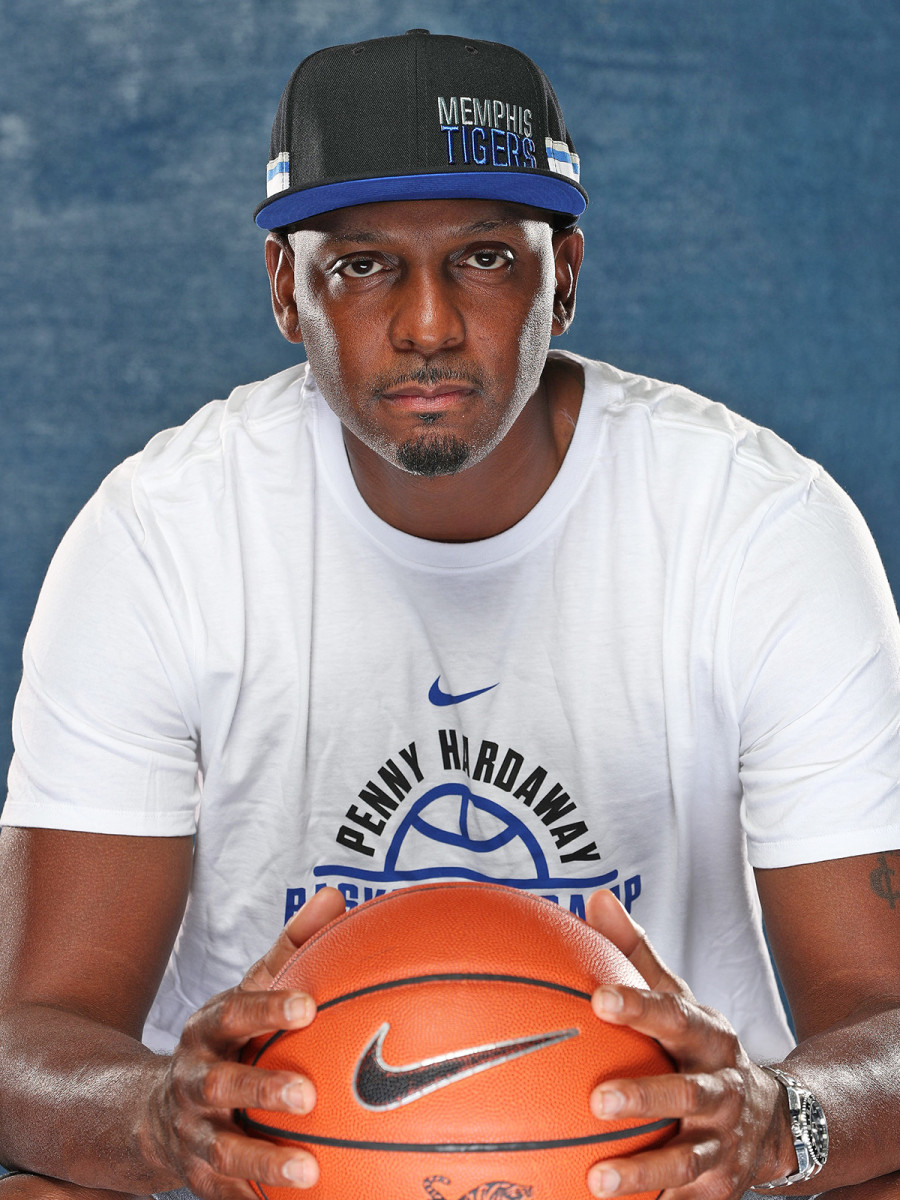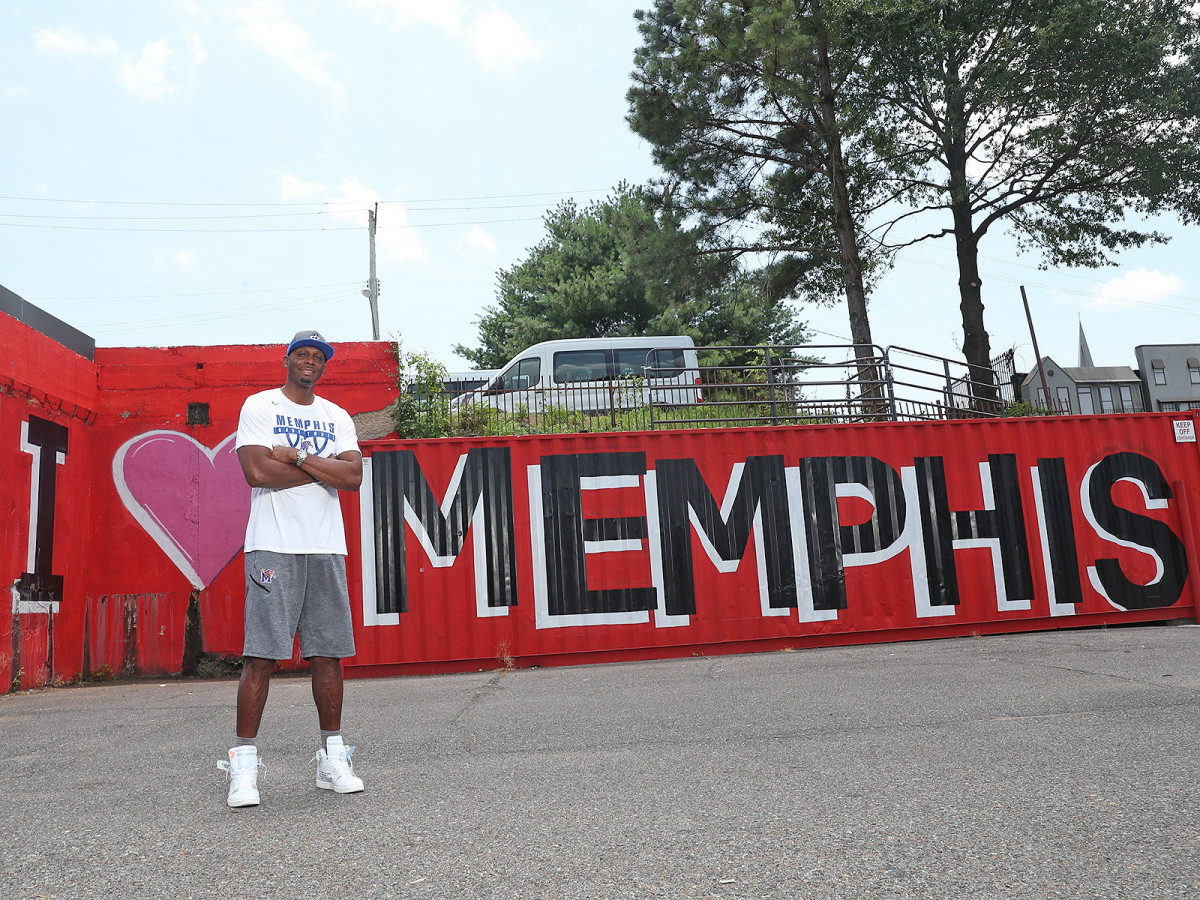It Had to Be Penny: Hardaway Begins Quest to Restore Memphis Basketball to Glory

This story appears in the Sept. 24–Oct. 1, 2018, issue of Sports Illustrated. For more great storytelling and in-depth analysis, subscribe to the magazine—and get up to 94% off the cover price. Click here for more.
Let’s start with the shoes. People are always talking about Penny Hardaway’s shoes. Not necessarily the ones he’s wearing now, during a midday break at his basketball camp in June: Virgil Abloh-designed Off-White (but all-black) Nike Vapormaxes, with a red plastic tag fashionably dangling from the left one’s laces. He owns these, but they’re not his. Those would be the Nikes that bear Hardaway’s 1 CENT logo (the numeral stabbing through a stylized C) and are still sold in color schemes—and at prices—that stretch the imagination. He wears a version of those four or five times a week. Sometimes a recruit will have them on while talking to Hardaway, unaware of the connection until an onlooker chimes in to say, “Hey, those are his shoes.”
“They just like the shoe,” Hardaway says. The shoe is cool.
This, since being hired as the coach at Memphis in March, has been a big part of Hardaway’s job: being cool. Or, more specifically, making Memphis basketball cool, in a way it hasn’t been for some time. Four years have passed since the Tigers made any postseason tournament, their longest drought in almost four decades. Attendance has cratered. Revenue too. Hardaway’s hiring was the second coaching change in 23 months.
This time is different, though, or at least it feels as much. The local reaction has been “ecstasy,” says longtime Memphis newspaper columnist and talk radio host Geoff Calkins. “It’s been crazy, over-the-top stupid.” Take the hat that, on the same June afternoon, Hardaway had set on the conference room table between a half-gone bag of peanut M&M’s and an unopened Dr Pepper. It’s a simple black number with MEMPHIS TIGERS stacked on one side above a flat, blue brim. After Hardaway was pictured wearing it on an April recruiting trip to Texas, the school’s bookstore sold its entire stock of 144 in a week. The shop also printed up 288 IN PENNY WE TRUST shirts, which were gone in hours. A second shipment sold out just as quickly.
Sure, it would be exciting anywhere if the local college’s new coach was a hometown hero or an alumnus or a former NBA All-Star, and especially if he was all three—and especially if he had just coached a city high school to a state-title three-peat. But this is Memphis, a city that smokes its ribs, treasures the blues and desperately loves its basketball.
The Top 10 Toughest Arenas for Opponents in College Basketball
Fifty years ago, after Martin Luther King Jr. was assassinated at the Lorraine Motel downtown, deeply rooted racial tensions boiled over. Riots broke out; white flight intensified; Time magazine described the city as a “Southern backwater.” Five years later, led by point guard Larry Finch, a Melrose High grad, the Tigers reached the 1973 NCAA title game. “What pulled us out of those doldrums,” says lifelong resident and university trustee Cato Johnson, “was the University of Memphis basketball program.”
The Tigers have continued to fill an outsized role for a city that has long been among the poorest of its size, that for decades pined futilely for the validation of a major pro sports franchise. Yet even when the NBA’s Grizzlies finally arrived from Vancouver, in 2001, players were often perplexed by their secondary spot in the local sports pecking order. When Memphis is rolling—when Dana Kirk was reeling off Sweet 16s in the 1980s, when John Calipari and Derrick Rose reached the Final Four in 2008—the success breeds civic goodwill. But, says Johnson, “when the program is down, the community feels down. It’s reflected in the overall fabric of the city.”
And so, it turns out, is the joy experienced when the city’s favorite non-Elvis son takes the reins of its favorite team. “You can be in Orange Mound, East Memphis, South Memphis, Germantown, Boxtown,” says Johnson, “and everybody feels they’re a part of this.”
“He instantly fixes everything,” says Calkins of Hardaway. “He sells tickets again. He fixes recruiting right away. He makes them relevant. It had to be Penny.”

This certainly wasn’t the way Hardaway saw his post-NBA life unfolding. He envisioned plenty of golf. Maybe yukking it up on a studio TV panel alongside some other former players a few times a month, checking in on the downtown barbershop-slash-beauty-salon he owns. Coaching didn’t enter the equation until 2011, when he volunteered as the eighth-grade boys’ coach at Lester Middle School, filling in for Desmond Merriweather, who was undergoing treatment for colon cancer.
Hardaway and Merriweather had known each other since they played on the blacktops in Binghampton, the Midtown neighborhood where Hardaway grew up in his grandmother’s shotgun home and a series of public housing apartments. From there Hardaway blossomed into the nation’s top recruit, courted by early-1990s powers like UNLV and Arkansas, but he elected to play at what was then Memphis State. (The school changed its name in ’94.) “It was the thing to do,” Hardaway says. “I don’t think anybody even thought about going anywhere else.” Memphians flocked to the just-opened Pyramid Arena to watch the hometown-kid-turned-college-star—playing under Finch—lead the team to the Elite Eight in his first season (’91–92).
A year later Hardaway finally left town as the No. 3 pick in the NBA draft. He teamed with Shaquille O’Neal to transform the Magic from expansion team to title contender, Hardaway’s stellar and versatile play as a 6' 7" point guard bridging the gap between the sui generis of Magic Johnson and the 21st century’s positionless stars. He became a sensation, memorably costarring in the film Blue Chips with O’Neal and Nick Nolte and in Nike’s iconic Lil’ Penny ad campaign alongside a doll voiced by Chris Rock. A left knee injury in ’97–98 would set his career on a new, star-crossed path that ultimately included six surgeries over 10 seasons of varying effectiveness in Phoenix, New York and Miami.
Still, Hardaway’s heart never left Memphis. He returned for summers and decorated the entrance to his $5 million mansion in Paradise Valley, Ariz., with photos of his modest childhood homes. The plan was always to move back for good once he retired, which he did in 2008. He had maintained ties to the city—resuscitating a dormant summer league, opening the barbershop, donating $1 million for the university to build its sports hall of fame—when Merriweather asked him to help coach at Lester Middle.
Hardaway took easily to the gig. He saw himself in many of the kids, trying to excel despite the noise in their lives, and he felt invigorated by the challenge of bringing them together. And Lester won: city and state titles in that first season, 2011–12, then again in each of the next two. Hardaway founded an elite AAU program, Team Penny, while Merriweather was hired as the coach of East High. After a brief break from school coaching, Hardaway planned to join Merriweather as an assistant. But Merriweather did not live through that first season. In the fall of 2015, Hardaway took over; that winter the Mustangs won Tennessee’s Class AAA championship. They did it again in 2017. And again this past March. With each step to the next level Hardaway internalized the doubts he would hear about whether he could sustain his success. “That’s fuel,” he says now. “This is what I was born to do.”
As Hardaway conquered the local schoolboy scene, his alma mater faltered. In seven seasons under Josh Pastner, Calipari’s successor, the Tigers never made it past the NCAA tournament’s first weekend. When Pastner left for Georgia Tech in 2016, Memphis hired Tubby Smith, whose preference for slowly building with less-heralded prospects proved an imperfect fit. “What Memphians want in a basketball program is top 20 recruiting rankings,” explains Calkins. “They want flash. They want local kids.” Smith’s two seasons provided none of the above. The four top 100 prospects he inherited from Pastner transferred out. The Tigers’ pace of play stagnated. He didn’t land a single area recruit.
The effect was stark. Average attendance dropped to 6,225—a 48-year low and about a third of FedExForum’s 18,119-seat capacity. Revenue was projected to dip by $4.7 million. Donations to the athletic department fell by $1.1 million, even as the football team reached a school-record fourth straight bowl game. The Tigers had lost their city.
By February 2018, the financial picture had become grave enough to concern the university’s president, David Rudd. During a stretch of five losses in six games, Rudd began internal discussions about the possibility of a coaching change. After Memphis lost the American Athletic Conference tournament semifinal to South Florida on March 10, he phoned members of the school’s executive board to begin the process. Hardaway’s contract negotiations began the next day, even as Smith had yet to be fired and East High’s season had yet to finish. Says Johnson, the board of trustees member, “My Plan B was going to be prayer.”
Four days after leading East to a third state crown, Hardaway was introduced at a press conference in the lobby of the school’s $20 million, five-month-old basketball center. Cheerleaders handed out business cards featuring Hardaway’s likeness with a penny attached. The event was so popular that many people were left watching through glass from the portico. When Hardaway mentioned having “that Memphis blood in me,” you could practically feel an entire fan base swoon.
Rick Pitino Recounts How He First Learned of the Louisville Escort Scandal
Not that support for the move was universal. Critics blasted the school for its quick dismissal of Smith, with ESPN’s Jay Bilas tweeting that “Memphis should be embarrassed.” Smith’s attorney, Ricky Lefft, spoke conspiratorially, telling The Commercial-Appeal, “If you’ve got somebody that wants the job and they’re controlling most of the talent in the city, I’m not casting aspersions. I’ll let you draw your own conclusions.” (Smith, who was hired by his own alma mater, High Point, told the paper, “I wish Penny well and I’m sure that he’ll get it done there.”) Hardaway dismisses Lefft’s implications. “There’s no way I can control the talent in Memphis,” he says. “I’m not that powerful.”
Perhaps not. But within hours of Hardaway’s introduction, four-star point guard Alex Lomax—Tennessee’s two-time Class AAA Mr. Basketball, who played for Hardaway at East High and even lived with him for years—switched his commitment from Wichita State to Memphis. Another four-star guard, Tyler Harris, who played for Hardaway’s rivals in high school and AAU, signed with the Tigers too. In a matter of weeks Hardaway had landed a top 30 recruiting class. He’s also had an in-home visit with East High forward James Wiseman (currently the No. 1 player in the class of 2019) and landed a verbal commitment from teammate Malcolm Dandridge (a four-star prospect himself). The university, which cheekily raised its season-ticket prices by one cent, projects a $4.5 million increase in ticket sales this season. Even in the summer, the city buzzes with anticipation.
“When you’re in Memphis, a great deal of what you look for is hope,” says Johnson, after rattling off bleak statistics about local poverty levels. “Penny means so much to the community because it gives the city something to say, ‘Wow, we feel good about ourselves.’ This is not something a political leader can do. This is not something you see a faith-based leader doing. That is a lot to put on one person’s shoulders. But he wears it well.”

Very little has eluded Hardaway so far. There was his attempt to get the 1 CENT logo on the Tigers’ jerseys, which Nike declined in favor of keeping its swoosh as the uniform’s lone branding, which means Hardaway will have to settle for his logo only gracing their sneakers and off-court apparel. He’s working on persuading Calipari to agree to a Memphis-Kentucky home-and-home series, but says Cal is balking at what would surely be a complicated return.
But yes, Hardaway is otherwise winning the offseason. There is—naturally—some skepticism around the hiring of a legendary alumnus with no collegiate coaching experience. For every Fred Hoiberg, who jumped from the Timberwolves’ front office to revive Iowa State in 2010, there’s Houston’s ill-fated hiring of Clyde Drexler and Chris Mullin’s current struggle at St. John’s. Yet the risk here is not Memphis’s alone. “A lot of people were like, ‘Man, why would you put your legacy on the line?’” Hardaway says. “I don’t look at it that way. I’m coming here to win. And I know that I can do that.”
He has not been shy about much. He wants to see Tigers flags waving from cars again. He wants every basketball-loving kid in the city to not even dream of leaving it. He wants his team to play the way Memphians like: “grimy on defense and explosive on offense,” he says, which means aggressive pressure on one end and a Mike D’Antoni–inspired attack on the other. With the incoming talent and several returnees from last season’s 21-win team, he can foresee an AAC title this season. Within five years the goal is a national championship. Here Hardaway is asked if he has considered more moderately managing expectations, if perhaps he might be setting the bar too high. “There’s no such thing,” he says. “Not in my world.”
It will be months before we get any idea how reasonable this boast is, years before we know for sure. For now Hardaway can only talk the talk. On the following June morning that means playing a round in a PGA pro-am at the TPC Southwind in Germantown; Hardaway’s home is along the course. In his fivesome are Tour stalwart Charles Howell III, FedEx exec Matthew Thornton III, Super Bowl champion coach and NASCAR impresario Joe Gibbs, and Memphis football coach Mike Norvell, a group that finishes the day atop the leaderboard. More important, Hardaway spends plenty of time shaking hands, posing for selfies, waving to fans who shout their support—stoking amity on a sunny summer morning where the cheers come easy.
As Hardaway approaches the 18th hole, a dogleg left par-4 with no straight path to the pin, an affable event volunteer in a blue polo and khaki shorts pipes up. “Been waiting for this one, Penny,” he says. Hardaway grins, nodding, and steps to the tee.
